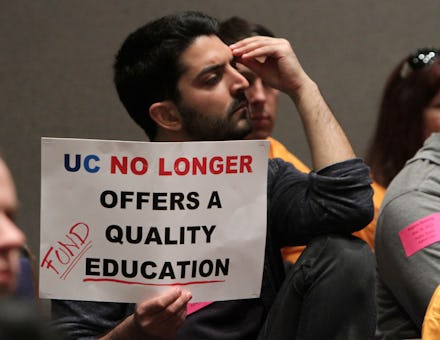Student Debt is Now a Weapon in the War on Diversity

The weight of student debt repayment is crushing no matter your background. Everyone who takes out federal student loans is forced into a system where government and university officials profit off of the exploitation of young borrowers. But not everyone feels that weight in the same way: marginalized communities — in particular, women, people of color, LGBT folks — are confronted with unique obstacles to loan repayment, and have an experience of student debt that warrants compassionate retribution on the part of debtors.
A 2012 study by the American Association of University Women illuminated how the wage gap between men and women hinders womens’ ability to efficiently pay off student loans — and the long-term affects of drowning in debt.
Women earn only roughly 82% of what men earn across industries right out of college and, as the report states, "because women earn less than men do after college, student loan repayments make up a larger part of women’s earnings." Many high-paying jobs, particularly in STEM careers, are notoriously unsafe spaces for women — but even entry-level internships that could lead to better waged positions can be threatening in such a way that advantages men. This inequality of opportunity out of the gate makes long-term success more daunting for women, and keeps them burdened with interest-collecting student loans for much longer.
But the wage gap isn’t just about the gender binary. A study by NYU and University of Chicago professors in 2008 noted the way in which earnings for transgender folks changed after their gender transition — for male-to-female workers, the pay fell by almost one third. Female-to-male workers actually experienced a slight pay increase — potentially attributable to sexism — although both face significant workplace harassment and hiring/firing discrimination based on their gender identity.
Other LGBT identities have similar experiences — even controlling for race and education, gay and bisexual men earn 32 percent less than their straight counterparts. The same principle for recent graduates applies here: the more disadvantaged you are in your earnings, the longer it will take to pay off your student loans. The longer you’re crushed under student debt, the more overwhelming the barriers to success can be — especially when debt collectors start nipping at your heels.
This problem extends far beyond wage and achievement gaps, though. Students of color straight up rely more on student loans to fund their college education — for 2008-9, one in three black students owed more then $38,000, and one in two American Indian students owed more than $21,000. Naturally, postgraduate unemployment makes loan repayment impossible: graduates of color face a significantly higher youth unemployment rate than white graduates — African American youth (16 to 24) face double the white youth unemployment rate, at 30 percent. Latino youth face 20 percent. Recent cuts to certain loan programs have also taken a particular hit on historically black colleges like Howard, as the students of color who relied on those programs could no longer afford to enroll.
Note that a lot of these modes of inequality don’t seem to be caused by outright, conscious discrimination on the part of employers or lawmakers. The fact is that not everyone feels the effects of certain policies and positions in the same way — historically, our treatment of marginalized communities has created a society where even if everyone’s on the same field, they don’t have the same opportunity. The damage of a colorblind, gender-blind student loan system is that we might never even hear the stories of some women of color who struggle to pay back their loans because they’re unable to justify entering the system in the first place.
We can’t rely on waiting to hear the voices of students calling out for help from the quicksand of loan repayment — we have to look at how the system itself inevitably targets certain identities, and take responsibility for correcting it before those voices need to speak out at all.
We should not only consider these injustices in the larger picture of the oppressiveness of the federal loan system, but we should find strength in the shared experiences of all those crushed by student debt, while illuminating how those experiences are unique.
Our generation deserves better than a system that targets them for profit, and better than a society that continues to undermine the already marginalized. We’re all tasked with supporting the disadvantaged. The crafters of the American student loan structure — our administrators, our policymakers, everyone who blames students for their plight — should do the same.